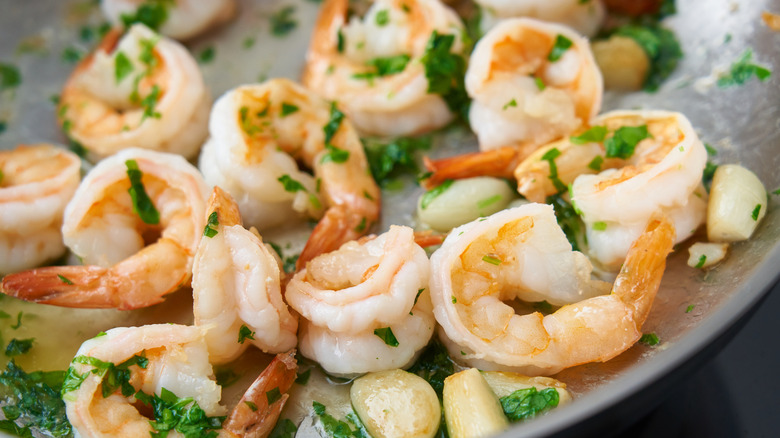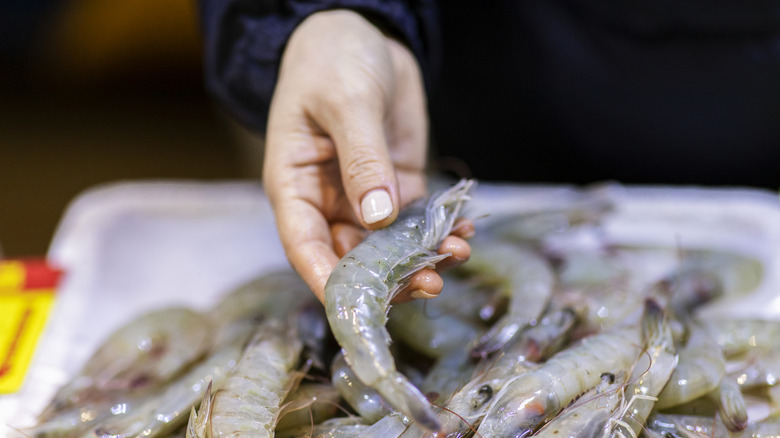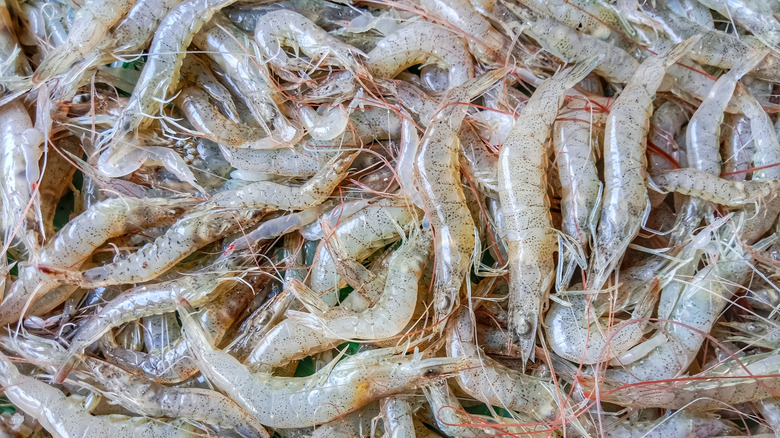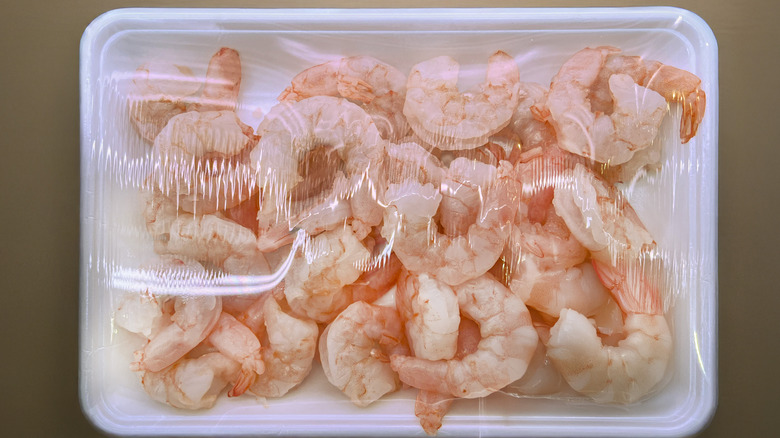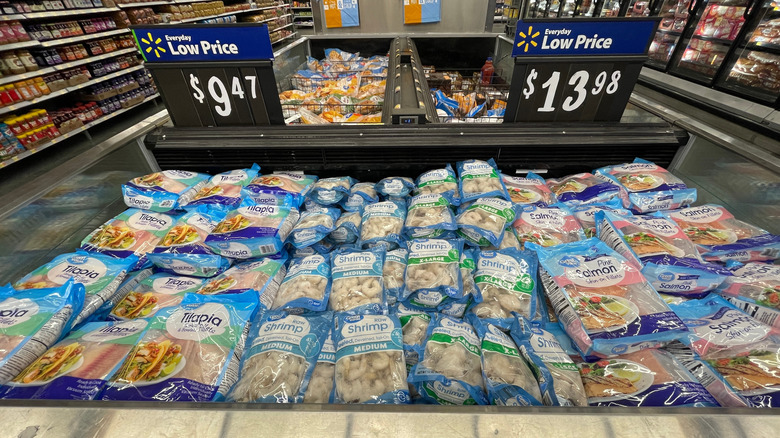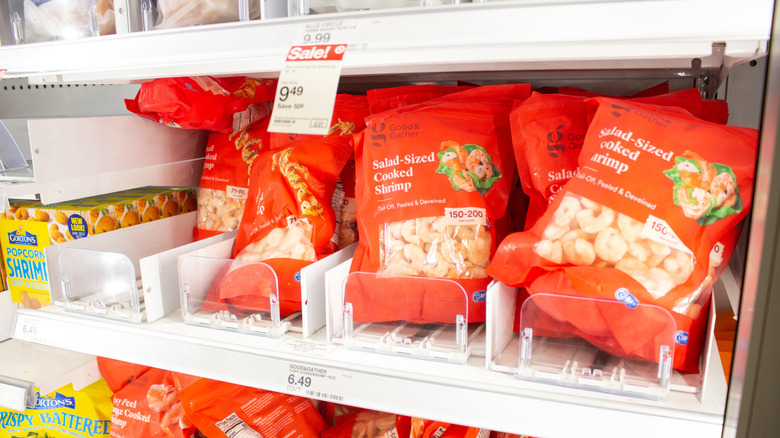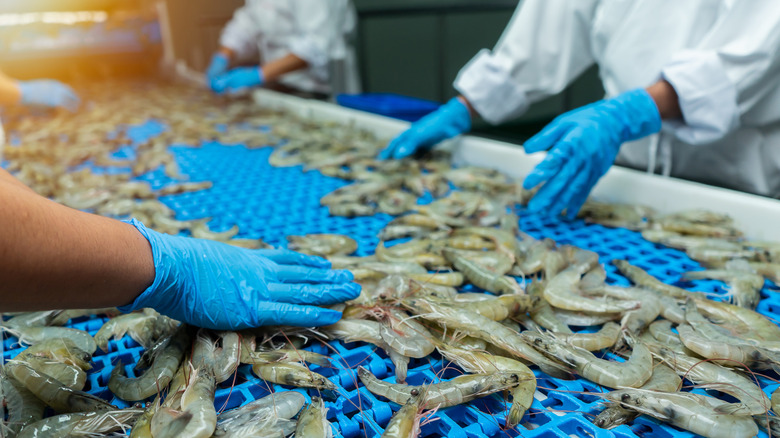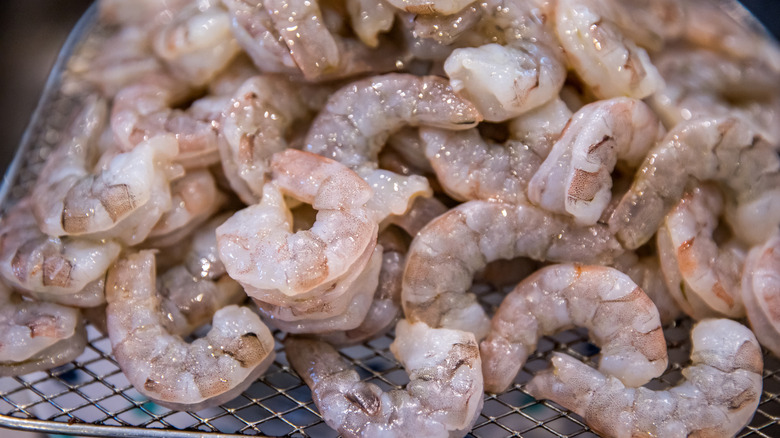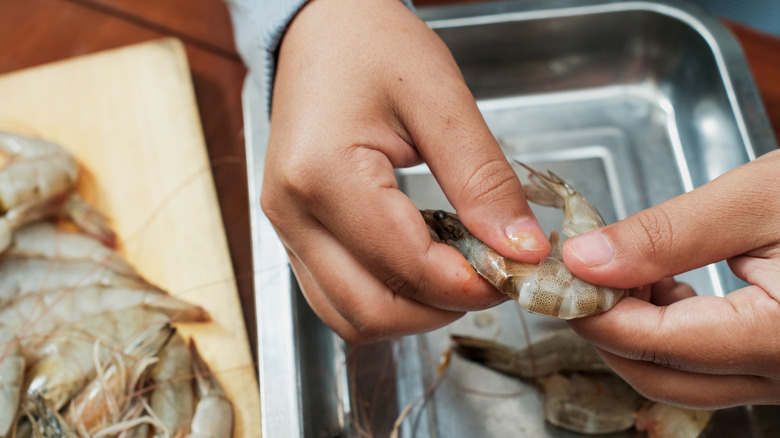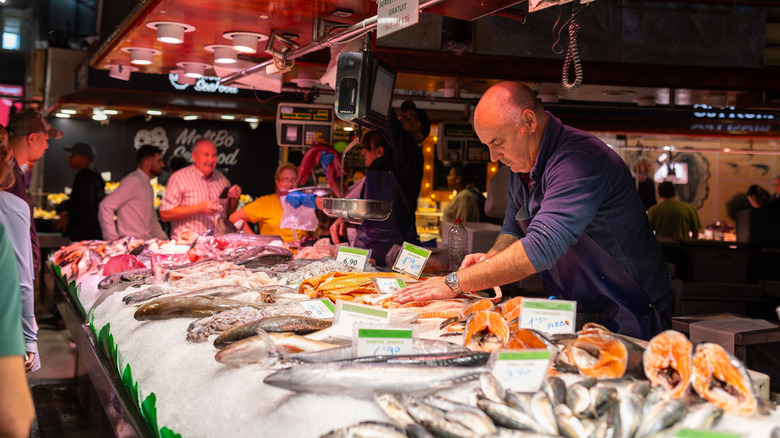10 Shrimp-Buying Secrets Every Shopper Should Know
It's estimated that the average American eats between four and six pounds of shrimp per year — and yet buying and cooking these crustaceans for ourselves can still feel like a culinary challenge. As any die-hard seafood lover will tell you, shrimp quality isn't always consistent. The shrimp you find at the grocery store seafood counter, or even in the freezer aisle, isn't all created equal.
If you manage to purchase the best-of-the-best shrimp, you're in for a slightly sweet and succulent seafood experience. Should you be unlucky enough to pick up some not-so-high-quality shrimp, you risk missing out on the optimal flavor and texture that makes this seafood specialty so popular in the first place. Nobody wants to end up in that latter category. Bad shrimp is not only a disappointment to the taste buds, but to the wallet, too. Few things are quite as dismaying as splashing out on what you think will be a top-notch meal, only to sadly scrape an uneaten plateful into the trash and order takeout instead. That's why we turned to two pros fluent in the art of good shrimp.
With the help of Travis Watson — the executive chef for the Blackbird eatery at Santa Barbara's Hotel Californian — and Kaitlin Sharbo, an executive chef for Cameron Mitchell Restaurants, we've compiled the ultimate shrimp shopping guide. From analyzing the scent of fresh shrimp to learning the surprising benefits of befriending your local fishmonger, the tips of these experts will help you pick up the freshest, sweetest, and juiciest shrimp every time.
Farmed shrimp and wild-caught shrimp may taste different
One of the first things you may notice when shopping for shrimp is a label indicating whether said seafood is farmed or wild-caught. The labels are pretty self-explanatory. If shrimp is farmed, that means it was sourced from a controlled environment, which makes it easier to produce a steady supply. Wild-caught shrimp is, well, caught in the wild. According to WWF, the farmed variety comprises some 55% of the shrimp produced worldwide. However, just because farmed shrimp is more readily available, that doesn't necessarily mean it's the most flavorful option, as Travis Watson claims that this variety can taste notably different from its wild-caught counterparts.
"Farmed shrimp are much more likely to be diseased because of their farmed conditions, and when shrimp farms have to treat their shrimp, the chemicals and medicines often affect other wildlife," Watson says. "The diet of a shrimp really affects the flavor of that shrimp." In other words, if farmed shrimp haven't been raised on naturally occurring food, your taste buds might be able to tell.
At the same time, you shouldn't completely discount farmed shrimp. While Kaitlin Sharbo insists that "wild-caught shrimp is easily some of the best-tasting shrimp out there," she also notes that a huge perk of farmed shrimp is that it makes this protein more accessible to those living in locations that may not have ready access to wild-caught seafood. Should you be limited to farmed shrimp at your local store, Sharbo recommends looking for sustainably sourced options.
Cloudy shrimp is a red flag
They say that you shouldn't judge a book by its cover, but when it comes to shrimp, you may want to ignore that advice. With a quick glance, you may very well be able to single out high- (and low-) quality shrimp. Just follow Kaitlin Sharbo's one straightforward rule: "Fresh shrimp should have translucent meat and clear shells, not cloudy," Sharbo says. Furthermore, cloudiness isn't the only form of discoloration that may indicate not-so-fresh shrimp.
In fact, any discoloration on shrimp should be taken as a bad sign. Shrimp are ordinarily a light pink or gray color. A select few varieties, such as royal red and Pacific pink, can have slightly darker hues. Any coloring that falls beyond these parameters should serve as a major red flag that the shrimp is past its best.
If you're not 100% certain that the shrimp's color looks good, it may be best to pass on it. Like all shellfish, consuming spoiled shrimp puts you at risk of developing a foodborne illness with symptoms such as vomiting, diarrhea, or nausea. In extreme cases, ingesting toxins in shellfish can be fatal. Better safe than sorry.
Seek out BAP, ASC, and CBIB certified shrimp
When scanning the labels on your shrimp, you may notice claims that the seafood is BAP, ASC, or CBIB certified. This is more than just technical industry jargon — these certifications can tell you a lot about how your shrimp was farmed or sourced, helping you make informed shopping choices. In Travis Watson's opinion, your go-to should be shrimp labeled as ASC (Aquaculture Stewardship Council) certified. Recognized in over 115 countries, this label means that shrimp farmers have provided evidence of utilizing responsible labor practices, as well as conducting disease management and ecosystem conservation.
As per Kaitlin Sharbo, BAP (Best Aquaculture Practices) certification is also a green flag. "BAP certifies sustainability and quality in every step of the production chain, in addition to providing a clear chain of custody from the hatchery to harvest," she explains. Similarly, CBIB certification (issued by Indonesian authorities, with the acronym's translation equating to Good Shrimp Cultivation Methods) can also indicate that shrimp is both high-quality and sustainably sourced. This distinction is based on criteria such as cultivation processes, the use of certain feeds and chemicals, and water quality.
Shrimp lacking these certifications won't necessarily let you down on the flavor front. However, if you want to ensure consistency in the quality of your seafood, seeking out shrimp with these certifications is one of the easiest ways to do that. If you're ever unsure about the origin of your shrimp, talk to your local fishmonger, who should be able to point you in the right direction.
Fresh shrimp are often sweeter than frozen
The biggest dilemma many shoppers face is choosing between fresh and frozen shrimp. Thankfully, almost anyone can learn how to cook frozen shrimp without thawing, and this variety can be stored for much longer than fresh shrimp. Additionally, frozen shrimp is frequently more affordable than the fresh variety, making it accessible to more shoppers. However, if your biggest priority is securing the sweetest shrimp possible, you may want to opt for the fresh stuff. "There is a noticeable difference between fresh and frozen shrimp," explains Travis Watson. "Any time fresh shrimp are available, that is always my preference. Fresh shrimp are usually sweeter, more tender, and less 'fishy' than their frozen counterparts."
Before giving the supermarket's frozen seafood section the cold shoulder, Kaitlin Sharbo stresses that frozen shrimp is still "delicious" and worth considering. If you reside in a landlocked state, for example, buying fresh shrimp may be harder or more expensive than it is for those residing near the coast. In that case, frozen shrimp is better than no shrimp — and, as Sharbo points out, even shrimp that is labeled as fresh may have been frozen at some point. "Most shrimp you will see in your high-end grocery store is either frozen or previously frozen," she claims. "With the regulations and standards set by both CBIB and BAP, shrimp is frozen at the time of harvest, ensuring freshness and quality."
Quality shrimp shouldn't smell fishy
Your nose is your best friend when it comes to identifying high-quality shrimp. This food may come from the sea, but good shrimp should never smell fishy — and if it does, we suggest looking elsewhere. In other words, don't be afraid to give your seafood a quick sniff before purchasing it. "It is not only acceptable but encouraged to ask your local fishmonger if you can give the shrimp a smell," says Kaitlin Sharbo. "Shellfish and fish should always smell like the ocean."
It's definitely best to avoid shrimp with an aroma similar to ammonia. That's a surefire sign that your shrimp isn't just low-quality, but it's actually started to decompose, with the odor caused by the release of trimethylamine. The worse the shrimp smells, the further along it is in the decomposition process. Sometimes, this smell may only become apparent once the shrimp is cooked, in which case you also need to relegate your meal to the trash ASAP.
Shrimp aside, if you ever think that your seafood smells similar to cleaning products — or worse, human urine — this is one of the clearest signs that your seafood isn't fresh. This should always serve as a major red flag when buying shrimp, even if you only smell or taste ammonia for a fleeting moment. Do yourself (and your stomach) a favor, and give it a miss.
Less is more on the ingredients list
We know what you're thinking — shrimp is just shrimp, right? As it turns out, that's not always the case. Peruse the seafood section of many grocery stores, and you'll notice that packages of shrimp often have a handful of other ingredients listed on the label. These can range from standard additions like water to more scientific-sounding substances that act as preservatives.
As Travis Watson puts it, "truthfully, there should only be one ingredient on the list — shrimp!" However, if you're struggling to find shrimp at your local store with an ingredients list quite that concise, Kaitlin Sharbo suggests trying to find a product with the shortest list possible. "Ideally, I try to avoid shrimp that has been treated with sodium tripolyphosphate," she says.
Important to note is the fact that you don't need to avoid all processed foods that include additives like preservatives. It's these additions that prevent spoilage, and extend a food's shelf life. However, the presence of preservatives does indicate that food isn't necessarily in its freshest form possible. In the case of sodium tripolyphosphate — which is used to retain moisture, and is often found in frozen shrimp — it can also impact how well shrimp cooks. This preservative has a habit of leaving shrimp with a more rubbery texture in comparison to shrimp that isn't treated with sodium tripolyphosphate. If you're purchasing shrimp that isn't pre-packaged, a fishmonger should be able to tell you which preservatives it contains, if any.
The region where shrimp are from says a lot about quality
The vast majority of shrimp consumed in the U.S. is imported, with most of this seafood originating in Asia. Countries like China and Thailand are major producers in the shrimp industry. While many shoppers likely don't check the origins of their shrimp, both Travis Watson and Kaitlin Sharbo have strong preferences, as they insist that shrimp vary in flavor and size depending on the place of production.
Watson always tries to source shrimp that were harvested in American waters. "I prefer domestic seafood whenever possible," he says. "Locally, we have ridgeback shrimp and spot prawns that are some of the best in the world." Sharbo prefers fresh shrimp from the Florida Gulf region, or from Vietnam. But when it comes to size, that's a different story. "The best larger-sized shrimp or 'jumbo shrimp' comes from the fisheries in Southeast Asia," Sharbo explains, noting that this shrimp's production is overseen by the Asia-Pacific Fishery Commission. According to Sharbo, this organization "encourages an ecosystem approach to fisheries ensuring sustainability, and preserves the integrity of a marine ecosystem providing a quality product."
Everybody's taste buds are different. Gather a group of seafood enthusiasts for a global shrimp taste test, and you'll likely receive a varied range of top picks. The best way to determine your preferences is through trial and error. Once you find shrimp that you prefer, you may want to stick to shrimp sourced from the same region in the future.
Soft or slimy shells are a bad sign
"Slimy" isn't a word often used to describe tasty food. It's certainly not used to describe high-quality shrimp, since the shellfish is likely spoiled if you ever think this characteristic is applicable. Sliminess on shrimp often goes hand-in-hand with that aforementioned ammonia smell, with the combo acting as the biggest possible red flag that you definitely shouldn't buy — never mind eat — the shrimp in question.
This sliminess is caused by bacterial or fungal growth. It will often become most apparent when you pick up the shrimp, with a feeling like a fine layer of film has developed over its surface. Another telltale sign that the shrimp isn't worth buying is if it feels soft or squishy to the touch. The texture of fresh shrimp should be solid and a little bit chewy. If it's not, this is a pretty clear indication that the shrimp is decomposing, with its softness caused by natural enzymes breaking down the tissue. This will often happen more quickly if shrimp is left out at warm temperatures. Similarly to guidelines for determining when it is safe to eat cold leftovers, the optimal refrigerated storage condition for seafood is 40 degrees Fahrenheit or below.
To be clear, we don't recommend manhandling every piece of shrimp at your local seafood shop to assess the texture for yourself. Casting a keen eye over the shrimp's texture with these criteria in mind, and then asking to inspect a single piece of shrimp to confirm your observations, should be enough to conclude whether your prospective purchase has started to deteriorate.
Shell-on shrimp are often higher quality
You have two options when purchasing shrimp: opting for shell-on or shell-off. For the sake of convenience, some people prefer to shop exclusively for the latter. In doing so, however, you're potentially depriving yourself of a more flavorful dining experience.
The shells on shrimp are made of a tough substance called chitin. Not only does this substance contain water-soluble compounds that add flavor to shrimp meat when heated, but it also doesn't break down while being cooked, so the shell helps the meat retain moisture. Yes, this means that you have to put in the extra effort of peeling the shrimp once cooked, but the enhanced taste is worth the extra minutes. (The point of leaving the tail on shrimp is a more debatable subject.)
Even before you factor in its flavor-boosting abilities, shell-on shrimp is also often cheaper and of higher quality. Without its protective shield, peeled shrimp has a habit of getting damaged while being shipped. Additionally, there have been reports of modern slavery practices linked to the supply chain of peeled shrimp. Back in 2015, it was reported that numerous workers were peeling shrimp in poor conditions for extremely low pay at factories in Thailand. The same shrimp was allegedly used in the supply chains of stores such as Walmart, Kroger, Dollar General, and Whole Foods, as well as big-name chain restaurants such as Red Lobster and Olive Garden.
Your local fishmonger will have the best advice
The Beatles got by with a little help from their friends. We get by with a little help from our local fishmonger. For most of us, even the most in-depth research pales in comparison to the knowledge wielded by seafood experts. The finest fishmongers will serve as the Yoda of shrimp, guiding you with wisdom and oceanic expertise to the best shrimp available.
All of this is to say that Travis Watson recommends asking fishmongers for guidance when shopping for shrimp. These piscine pros should be able to provide answers on everything from harvest dates to the shrimp's origin and certifications. "They can always guide you in the right direction," Watson says. "They also often know what to expect in the coming days. Nothing beats having a friend in the business!" What's more, if you don't feel up to deveining your shrimp, this is one of the annoying tasks Whole Foods fishmongers will do for free.
Even on a personal level, building a relationship with your go-to fishmonger has its perks. As a seafood expert, they can point you to their own personal picks, ensuring that you get the freshest or tastiest offerings. Over time, your fishmonger may also learn about your preferences, and be able to steer you to the right shrimp for your taste buds.
